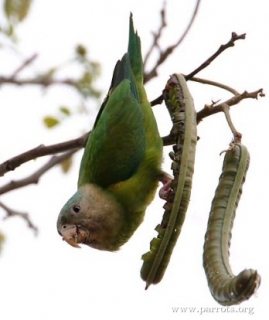Grey-cheeked Parakeet |
|
|
Also known as: Orange-winged Parakeet
Photos
View in GalleryDid You Know?
The Grey-cheeked Parakeet will nest in cavities in large trees or will take up residence in an arboreal termitarium (termite mound in tree.)Academic Research
Related publications: Brotogeris pyrrhopteraSpecies Profile
Genus: Brotogeris | Species: pyrrhoptera
Size:
20cm (7.8 in)
Weight:
45-60g (1.6-2.1 oz)
Subspecies including nominate:
one
Colour Adult:
Both adults green to yellow/green in general; blue/green crown; pale gray lores, chin and cheeks to ear coverts; dark blue primary coverts; orange/red underwing coverts and axillaries. Bill horn in colour with orange/brown tint. Eye ring bare and grey/white. Eye dark brown.
Colour Juvenile:
As in adults but with green crown without blue wash. Bill darker brown.
Call:
Calls made in flight are rapidly repeated trill notes. Calls while perched are shrill and unsong-like. Quiet otherwise.
Listen NowVideo Links:
Video 1More Information:
Content Sources:
CITES
BirdLife International
Cornell Lab of Ornithology/Birds of the World
Parrots: A Guide to Parrots of the World, Juniper and Parr, 1998
ML Media Collection Catalogue 122725, Grey-cheeked Parakeet Brotogeris pyrrhopterus, Macaulay, Linda, Guayas, Ecuador, Mar. 9 2002, Cornell Lab of Ornithology. Site
Parrots: Status Survey and Conservation Action Plan 2000-2004, Snyder, McGowan, Gilardi and Grajal, 2000.
Parrots of the World, Forshaw and Cooper, 1977. 2010 edition
Vanished and Vanishing Parrots, Forshaw, 2017.
Lexicon of Parrots, Thomas Arndt.
Parrots of the World, Forshaw, 2006.
Parrots in Aviculture, Low, 1992.
Photos
View in GalleryDid You Know?
The Grey-cheeked Parakeet will nest in cavities in large trees or will take up residence in an arboreal termitarium (termite mound in tree.)Academic Research
Related publications: Brotogeris pyrrhopteraSpecies Care
Captive Status:
Rare
Longevity:
15 yrs
Housing:
Aviary or suspended enclosure, minimum length 2m (6.5 ft).
Diet:
Fruit such as: apple, pear, orange, banana, cactus fruits, pomegranate, forming about 30 percent of diet; vegetables such as: carrot, celery, green beans, peas in the pod; fresh corn; green leaves such as: Swiss chard, lettuce, sowthistle, dandelion; spray millet; small seed mix such as: millet, canary and smaller amounts of oats, buckwheat, safflower and little hemp; soaked and sprouted sunflower seed; cooked beans and pulses, boiled maize, and complete kibble.
Enrichment:
Provide lots of toys to keep these active birds busy such as puzzle toys, foraging toys and branches, bird-safe woods and heat sterilized pine cones, vegetable tanned leather chew toys. Provide area for bathing.
Nest Box Size:
Nest log or 7" x 7" x 24" (17.8cm x 17.8cm x 61cm) vertical box.
Clutch Size:
4-5
Incubation Time:
25-26 days
Fledging Age:
6-8 weeks
Hatch Weight:
Not recorded.
Peak Weight:
Not recorded.
Weaning Weight:
Not recorded.
Specialist Club:
Photos
View in GalleryDid You Know?
The Grey-cheeked Parakeet will nest in cavities in large trees or will take up residence in an arboreal termitarium (termite mound in tree.)Academic Research
Related publications: Brotogeris pyrrhopteraSpecies Wild Status
World Population:
10,000-15,000
IUCN Red List Status:
Vulnerable
CITES Listing:
Appendix II
Threat Summary:
A BirdLife 'restricted-range' species. Primary threat is the wild bird trade, with nearly 60,000 birds reported traded almost entirely from Peru (but possibly having originated in Ecuador). Habitat is also being lost through logging, agriculture and overgrazing. Persecution as crop pest may be significant.
Range:
Found in SW Ecuador and extreme NW Peru.
Habitat:
Seen in variety of wooded habitats up to 1500m (4950 ft). Prefers primary deciduous woodland with Ceiba trichistandra but will also reside in degraded and secondary forests, premontane dry forest, arid Acacia scrubland and farmland with large trees next to forest. Also has been seen in banana plantations.
Wild Diet:
Feeds on flowers and seeds of large trees including Erythina, Chorisia and Cavanillesia plantifolia, Cecropia catkins, Ceiba fruits, Cecropia catkins and Ficus figs. Will sometimes feed on banana.
Ecology and Behaviour:
Found in pairs and flocks of up to a dozen, but rarely seen in groups of hundreds (less so in recent years). Will sometimes associate with other species of parrots including Red-masked Conures and Bronze-winged Parrots. Breeding is likely to coincide with the wet season.
Clutch and Egg Size:
4-5 rounded eggs, 23.0 x 18.0mm (0.9 x 0.7 in).
Breeding Season:
January-March. Needs large trees with hollow limbs for breeding; also uses arboreal termitaria.
Photos
View in GalleryDid You Know?
The Grey-cheeked Parakeet will nest in cavities in large trees or will take up residence in an arboreal termitarium (termite mound in tree.)Academic Research
Related publications: Brotogeris pyrrhopteraMembers Only Resources
Please log-in now to find more research, resources and tools.
Not a Member?
Find more great information:
Gain exclusive access to 600+ pages of additional research, seminars and podcasts, specialists to ask your toughest questions, and dozens of other fun resources - when you become a WPT member.
Join Today >>

































